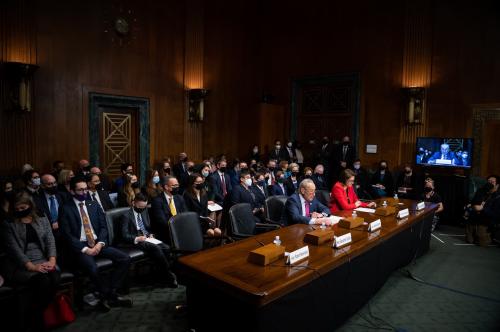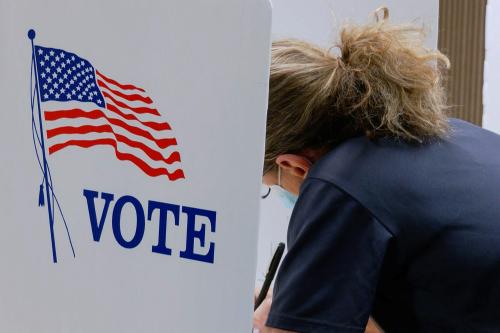Every day we are bombarded with polls telling us where the presidential race is. There are polls of the nation and polls of the swing states. There are so many polls that it’s hard to keep up. As we know, polls are merely a snapshot in time, subject to large variations and, at this point at least, they cannot foretell the future with any accuracy.
So, putting aside the polls, what other indicators are there on the state of the race? Until early voting begins, the two most important are voter registration and campaign donations.
This year, the most frequently discussed voter registration indicator was visits generated by Taylor Swift’s Instagram endorsement of Vice President Harris’ candidacy, which included a custom URL that her followers could visit to register to vote. The federal government’s General Services Administration (GSA) confirmed that 405,999 visitors were directed to the site in the 24 hours following Swift’s “childless cat lady” posting. More than 80,000 of them used the site to verify their registration status. At least 27,000 new voter registrations were generated the day following the posting, suggesting the endorsement was “swiftly” changing the composition of the November electorate.
But how many of these new registrants will turn out to vote?
Data collected by the U.S. Census Bureau suggests what’s likely to happen. It indicates that failure to register to vote is the greatest barrier to casting a ballot; once registered, the large majority of Americans of all ages vote. For instance, in the 2020 presidential election, 50.8% of 18- to 24-year-olds were registered and 86% of those cast a ballot. In that election, 70.15% of those 25 to 44 years old registered to vote, and 89.3% of them voted. Voter registration for those between 45 and 64 was 75.65%, while 93.7% of registered voters in the age cohort turned out. Among those 65 and older, 78.45% were registered to vote, and 94.8% of registered voters cast a ballot. These numbers suggest that around 80% of those who registered as a result of Taylor Swift’s endorsement posting will join the voting electorate this fall. Using the census data, the voting turnout percentages were calculated by dividing the number of those in an age cohort that voted in 2020 by the number of those in the cohort that were registered to vote that year.
This year, we have the benefit of a more comprehensive and current set of data on voter registration thanks to TargetSmart, a company that provides data-based consultation to political campaigns, businesses, and other organizations. They constantly update their files to record publicly available voter data, such as registration or early voting. When Target Smart analyzed the first wave of voter registration data from July, following “the switch” in the Democratic nominee, it found “incredible surges in voter registration relative to the same time period in 2020…especially [among] women, voters of color, and young voters.” Not coincidentally, those are the demographic groups that virtually all surveys suggest will be the key to Vice President Harris’ efforts to generate significant margins over Trump.
In the week after Vice President Harris became the Democratic nominee, TargetSmart’s report, based on data released by 38 states, found that women accounted for nearly 55% of all new registrants recorded. The July 2024 surge in the percentage of women registering to vote compared to men even exceeded the highest previous such imbalance which was recorded in the aftermath of the Dobbs decision in June of 2022. Young Black women led the way, with registration nearly tripling relative to the same point in 2020. Overall, Black women almost doubled their registration numbers from 2020; young Hispanic women registration increased by a 150%.
The same trends were evident in the data TargetSmart collected from those battleground states that have published their voter registration data so far. For example, in Pennsylvania, the proportion of new registrations from voters under 30 rose 59.6% compared to 2020. Black registration was up 110% overall—262% among Black women. The proportionate rise in registration for Democrats was more than double the rate for Republicans.
In North Carolina, 43% of new registrants were under 30 compared to only a 20% rise in 2020. In the week after Harris became the presumptive nominee, the total number of registrants was almost 50% higher than it was during the same week in 2020 (17,178 to 12,426).
The greatest proportionate rise among young voters in any of the battleground states occurred in Nevada where the number of Hispanic women under 30 registering to vote was three times the number in 2020. Black female registration doubled according to that state’s data.
Although we can’t say for sure what the partisan implications of this data are, these trends in voter registration seem to come from groups that have historically voted Democratic.
Another metric that seems to bear good news for the Democratic candidate is the amount of money each campaign has raised. The impact Harris’ candidacy is having on the composition of the electorate, evidenced in the new voter registration data, was reflected in the campaign’s August fundraising with 1.3 million of the nearly three million contributions coming from people making their first donation in 2024.
In August, the Harris campaign raised $361 million compared to Trump’s $130 million, representing a decline from his $139 million July numbers. In just the day following the debate, the Harris campaign raised $47 million from nearly 600,000 individual donors. Since she became the nominee, her campaign has raised almost double the amount of money the Trump campaign has. Of that amount, 41.63% came from donations of less than $200 compared to Trump’s smaller donor percentage of 31.71%.
So far, data from actual voter behavior such as voter registrations and campaign donations suggest that Vice President Kamala Harris’ campaign has been successful in motivating traditionally Democratic voters and increasing small donor money. If these trends continue, both nationally and in swing states, it could spell victory for her in November.








Commentary
Sick of polls? Here are 2 other ways to measure the presidential race
September 26, 2024